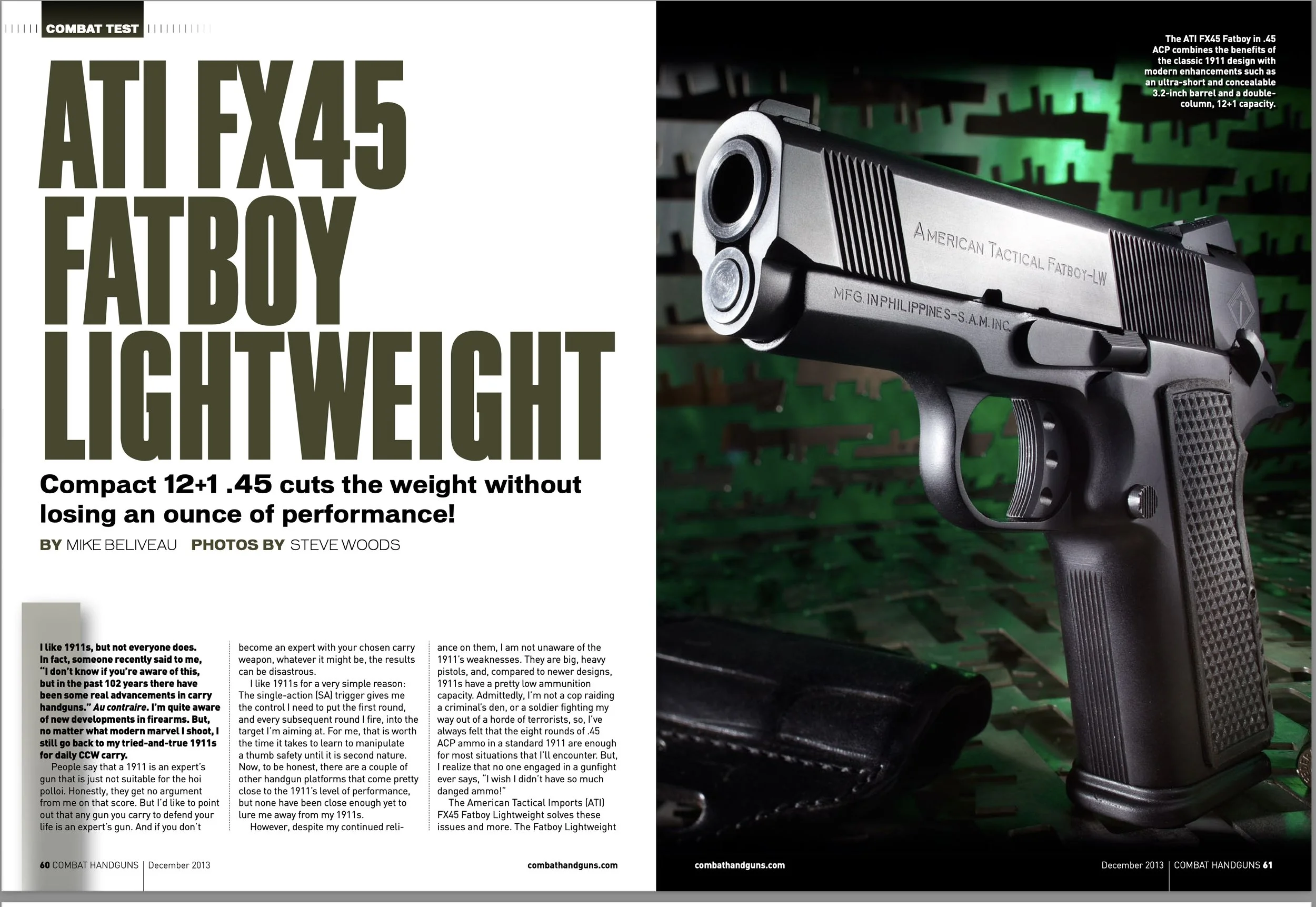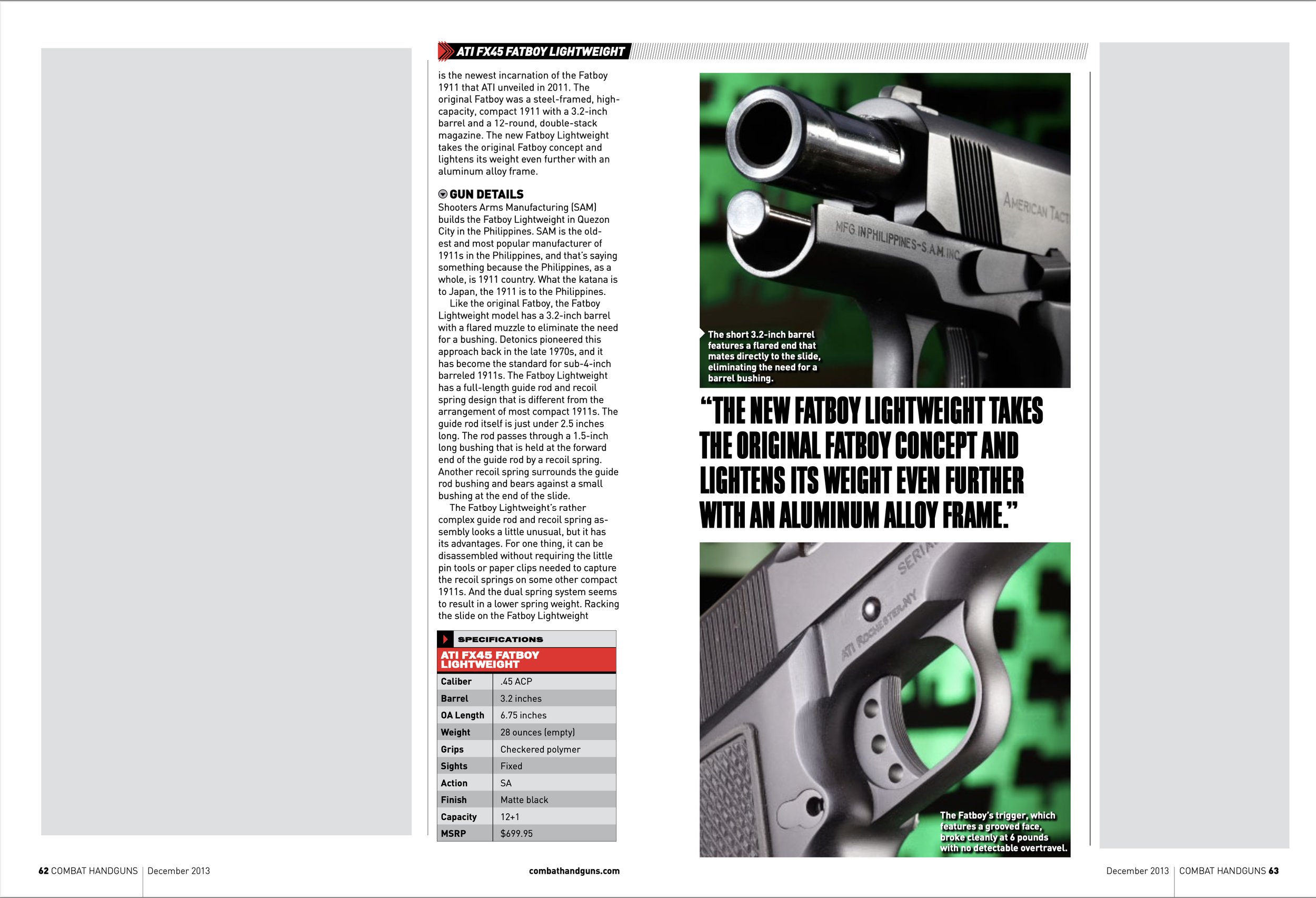ATI Fatboy Lightweight
Compact double stack 2011 in .45 ACP.
I like 1911s, but not everyone does. In fact, someone recently said to me, “I don't know if you’re aware of this, but in the past 102 years there have been some real advancements in carry handguns.”
Au contraire. I’m quite aware of new developments in firearms. But, no matter what modern marvel I shoot, I still go back to my tried and true 1911s for daily CCW carry.
People say that a 1911 is an expert’s gun that’s just not suitable for the hoi polloi. Honestly, they get no argument from me on that score. But, I’d like to point out that any gun you carry to defend your life is an expert’s gun. And, if you don’t become an expert with your chosen carry weapon, whatever it might be, the results can be disastrous.
I like 1911s for a very simple reason; the single action trigger gives me the control I need to put the first round, and every subsequent round I fire, into the target I’m aiming at. For me, that is worth the time it takes to learn to manipulate a thumb safety until it is second nature. Now to be honest, there are a couple of other handgun platforms come pretty close to the 1911’s level of performance, but none have been close enough yet to lure me away from my 1911s.
However, despite my continued reliance on them, I am not unaware of the 1911’s weaknesses. They are big, heavy pistols, and, compared to newer designs; 1911s have a pretty low ammunition capacity. Admittedly, I’m not a cop raiding crack houses, or a soldier fighting my way out of a horde of jihadists, so, I’ve always felt that the eight rounds of .45 ACP ammo in a standard 1911 would be enough for most situations that I’ll encounter. But, I realize that no one engaged in a gunfight, ever says, “I wish I didn’t have so much danged ammo!”
The ATI Fatboy Lightweight solves those issues and more. The Fatboy Lightweight is the newest incarnation of the Fatboy 1911 that American Tactical Imports unveiled in 2011. The original Fatboy was a steel framed high capacity compact 1911 with a 3.2-inch barrel and a 12-round, double stack magazine. The new Fatboy Lightweight takes the original Fatboy concept and lightens it up even further with an aluminum alloy frame.
Shooters Arms Manufacturing (SAM) builds the Fatboy Lightweight in Quezon City in the Philippines. SAM is the oldest and most popular manufacturer of 1911s in the Philippines, and that’s saying something because the Philippines, as a whole, is 1911 country. What the Katana is to Japan, the 1911 is to the Philippines.
Like the original Fatboy, the Lightweight model has a 3 3/8th inch barrel with a flared muzzle to eliminate the need for a bushing. Detonics pioneered this approach back in the late 1970s, and it has become the standard for sub-four-inch barreled 1911s. The Lightweight has a full-length guide rod and recoil spring design that is different from the arrangement of most compact 1911s. The guide rod itself is just under two and a half inches long. The rod passes through a one and a half-inch long bushing that is held at the forward end of the guide rod by a recoil spring. Another recoil spring surrounds the guide rod bushing and bears against a small bushing at the end of the slide.
The Fatboy’s rather complex guide rod and recoil spring assembly looks a little unusual, but it has its advantages. For one thing, it can be disassembled without resorting the little pin tools or paper clips needed to capture the recoil springs on some other compact 1911s. And the dual spring system seems to result in a lower spring weight. Racking the slide on the Fatboy Lightweight doesn’t require much more muscle than it does with a standard five-inch 1911. I was a little concerned by the light springs, but, after firing over 300 rounds through the Fatboy, I’ve yet to have a failure to feed or a failure to chamber completely.
The one thing I don’t like about the guide rod is that the base plate of the rod is a very thin steel plate that is attached to the rod by an allen’s head screw. I understand why SAM did it this way. Their complex spring and bushing system requires a removable base plate to be able to put the assembly together. But the baseplate is made of pretty thin steel for a part that is subjected to that much stress. I’ve had no problems, but I have read of base plates cracking on the original Fatboy.
The Fatboy Lightweight has a steel slide with a matt black finish. It has charging grooves at both the front and rear of the slide. As with most modern 1911s, the ejection port is lowered and relieved. The sights are both dovetail mounted. The front blade has a white dot, which is all but invisible. The rear sight is a Novak-style no-snag combat sight with a black face that has been grooved to reduce glare. It can be adjusted for windage by loosening a locking screw and drifting the sight in its dovetail.
The aluminum alloy frame is also finished matt black. The original Fatboy had no grip panels, per se, rather the frame itself was grooved to provide some purchase for your hand. I’m happy to say that the Fatboy Lightweight has not followed in its father’s footsteps. The Lightweight has black plastic grip panels that are checkered to give you something to hold on to. Because these grip panels are razor thin, the Fatboy Lightweight’s grips are essentially the same width as the handle on a conventional, single-stack 1911.
The controls on the Fatboy Lightweight are pure 1911. The slide release lever is pure G.I., which I prefer over the extended ones. The Armand Swenson style ambidextrous thumb safety has an extended shelf that is very easy to hit with either hand. The beavertail grip safety has a generous memory bump. And the burr hammer and the trigger are drilled for weight reduction.
The whole reason for a wide body 1911 is magazine capacity. The Fatboy LW is equipped with a 12-round, double-stack magazine. There are also 10-round magazines available for jurisdictions where that is the maximum allowed by law. The magazine supplied with out test gun worked with out a hitch, but ATI shipped the gun with only one magazine. In my opinion, all pistols should come with a pair of magazines. I thought I’d remedy that by drafting some of my Para mags into service with the Fatboy, but it was a no-go. I tried several of Para’s own magazines, and some Mec Gar’s clones. None of them fit the Fatboy LW. So, as far, as I can determine, ATI is the only source for spare magazines for your Fatboy Lightweight.
The trigger pull on the Fatboy LW is a bit on the heavy side of decent. It breaks at six pounds even. I think the ideal pull weight in a single action, self-defense pistol is five pounds, so six isn’t bad. The trigger isn’t adjustable for take-up or over-travel. On this gun there’s about one sixty-fourth of an inch of take-up before breaking cleanly. I can’t detect any over-travel at all.
At the range we tested the Fatboy Lightweight with three brands of factory ammunition. We ran it with Black Hills 230-grain jacketed hollow points, and with 230-grain full metal jacketed rounds from both Remington and Blazer. The Black Hills 230-grain JHP ammunition is what I carry in my personal CCW 1911s. I like it, and it didn’t disappoint me in the Fatboy LW. From a bench rest at 15 yards it shot groups averaging two and a half inches in diameter. The average velocity through the stubby 3.2-inch barrel was 706 feet per second.
The Remington 230-grain MC rounds were the next ones tested. Accuracy was close to the bar set by the Black Hills ammo. With each brand my best groups measured two inches across. But my average of five, five-shot groups with the Remington loads was three inches across. Velocity with the 230-grain Remmies averaged 701 fps.
The final test loads for the Fatboy were Blazer’s 230-grain FMJ bullets. The Blazers proved to be the most accurate of the three rounds tested. My best group with the Blazers measured an inch and a half across. The average of all five groups shot was only two inches in diameter. Like the Remington loads, the Blazers clocked in at an average of 701 fps
After the bench rest session I did some seven-yard rapid fire drills. I had no trouble keeping all 12 rounds in the nine and 10 rings on a full-sized B-27 silhouette target. Despite its light weight, the Fatboy was easily controllable in rapid fire shooting. My only handling gripe with the Fatboy Lightweight is that it ejects empties straight back. Quite often they bounced off of my forehead. This was a little disconcerting the first couple of times, but, after I shot the gun for awhile, I stopped noticing it.
The Fatboy fits in any holster that will accommodate a compact 1911. This winter I have been carrying it in either a Don Hume IWB holster, or in a hybrid Galco shoulder rig. It conceals as well as my compact single stack 1911s, but with almost double the firepower.
ATI Fatboy Lightweight performance:
Load
Velocity in feet per second (fps)
Accuracy in inches - Best group
Accuracy in inches - Ave Group
Black Hills 230 grain JHP
706
2
2.5
Remington 230 grain MC
701
2
2.75
Blazer 230 grain FMJ
689
1.5
2
Specifications:
ATI Fatboy Lightweight
Caliber: .45 ACP
Barrel: 3 3/8 inches
OA Length: 6 3/4 inches
Weight: 1 lb 12 oz Empty
Sights: Dovetailed front blade, dovetailed, no-snag rear
Action: Single-action semi-auto
Capacity: 12 + 1
Finish: Matt black steel
Stocks: Checkered black polymer
MSRP: $699.95
Points of Contact:
American Tactical Imports (ATI)
100 Airpark Drive
Rochester, NY 14624
800-290-0065

